Reece Bundle
How did Reece Group become a global leader?
From a single truck in 1920s Australia to a multi-billion dollar enterprise, the Reece SWOT Analysis reveals a compelling narrative. Explore the brief history of Reece Company, a story of resilience and strategic expansion. Discover how a humble hardware venture transformed into a plumbing and HVAC-R powerhouse, shaping the industry landscape.
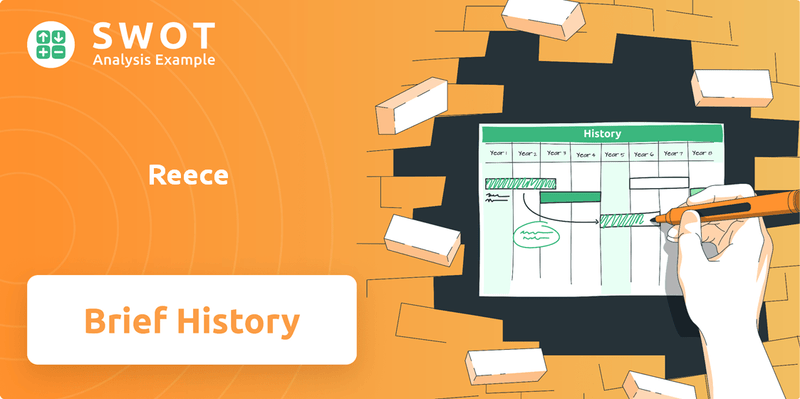
Delving into the Reece Company history unveils a fascinating journey of innovation and strategic adaptation. Learn about the Reece company founder and the early days of Reece Australia, tracing the key milestones that propelled its growth. This exploration will cover Reece company timeline, including significant Reece company acquisitions and expansion, to understand its current market position and future potential, including its impressive Reece company revenue.
What is the Reece Founding Story?
The story of the Reece Group began in 1920 with Harold Joseph Reece. He started the business in Victoria, Australia, selling hardware supplies directly to customers from his truck. This hands-on approach laid the groundwork for what would become a major player in the plumbing and hardware industry.
Later that year, Harold Joseph Reece opened the first store in Caulfield, Victoria. This marked a significant step, transitioning from a mobile operation to a fixed location. The company's focus was clear from the start: providing quality hardware and expert advice to tradespeople, particularly those in the plumbing sector.
While the exact initial funding details are not readily available, the early approach suggests a 'bootstrap' beginning. This meant relying on personal resources and reinvesting profits to fuel growth. This approach shaped the company's culture, emphasizing efficiency and customer service.
Several key events shaped the Reece Company history.
- In 1958, Les Wilson joined the board and began acquiring shares.
- By 1969, the Wilson family gained majority control, marking a leadership change.
- In 1970, Alan Wilson became CEO and merged HJ Reece with Austral Hardware.
- The Wilson family's leadership has been a defining factor in Reece's growth.
The entry of Les Wilson in 1958 was a turning point. By 1969, the Wilson family controlled the business. This was a significant shift in ownership and leadership. Alan Wilson, Les Wilson's son, took over as CEO in 1970. He combined HJ Reece with Austral Hardware. This consolidation was key to streamlining operations and expanding market reach.
The Wilson family's leadership has been a key characteristic of Reece's development. Their focus on long-term success, along with prioritizing customers and employees, has helped the company grow. This approach has been crucial in navigating the competitive landscape of the plumbing supplies market.
Today, Reece Australia has a significant presence in the plumbing and bathroom supplies market. While specific market share figures fluctuate, the company remains a major player. The company's expansion strategy has included both organic growth and strategic acquisitions, contributing to its broader reach and product offerings, known as Reece products. The company's journey from a single truck to a large enterprise shows its adaptability and commitment to serving its customers.
Reece SWOT Analysis
- Complete SWOT Breakdown
- Fully Customizable
- Editable in Excel & Word
- Professional Formatting
- Investor-Ready Format
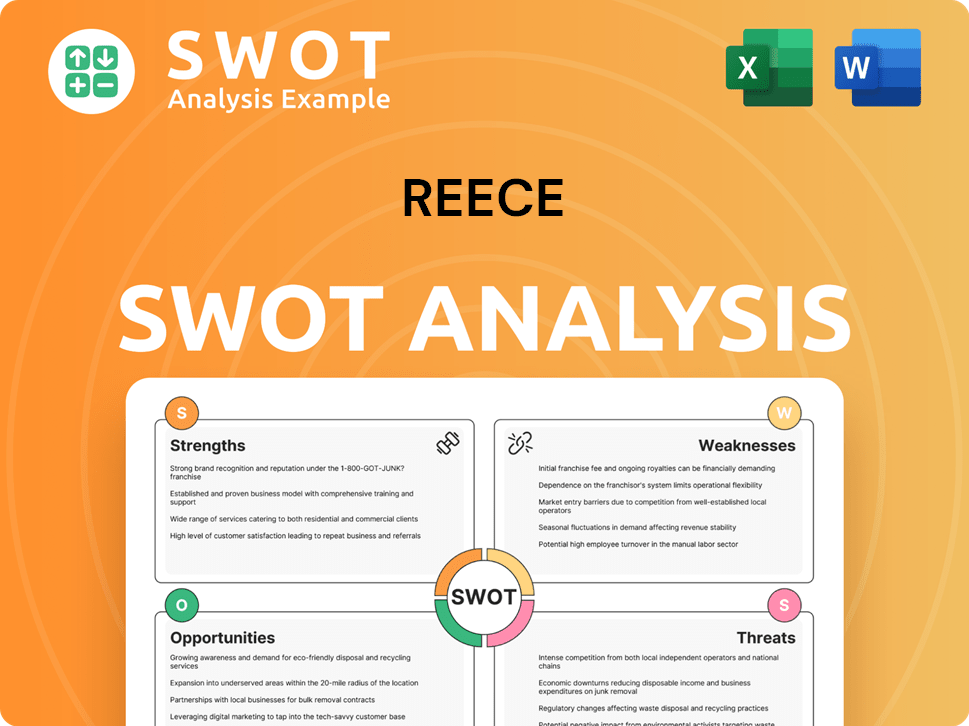
What Drove the Early Growth of Reece?
The early growth and expansion of the Reece Company, a key part of the Reece Group, marks a significant chapter in its history. Following the Wilson family's majority ownership in 1969, the company experienced considerable growth, transforming into a leading plumbing hardware distribution business in Australia. This period saw strategic expansions and acquisitions that solidified its position in the market, shaping the Reece company timeline.
Under Alan Wilson's leadership as CEO from 1970, the company flourished. A pivotal moment in the Reece company history came on January 1, 1974, when it was officially listed on the Australian Securities Exchange (ASX). This listing provided a platform for further expansion and investment, driving the company's growth trajectory.
Reece's strategy has consistently focused on expanding its branch network and entering new markets. By 1997, the company had established a nationwide presence in Australia, and in 2006, it expanded into New Zealand. This methodical approach has been key to increasing its market share.
A major strategic shift occurred in 2018 when Reece entered the United States market through the acquisition of MORSCO Inc. for A$1.9 billion. This significant acquisition, funded by a capital raising of $560 million, was a unique event in Reece's history of self-funded growth. For more insights into their target market, consider reading about the Target Market of Reece.
As of FY24, Reece operated 661 branches across Australia and New Zealand and 243 branches in the United States. The company continues to invest in its network, with plans to add 10-15 new stores in the US annually. In FY24, Reece undertook 15 refurbishments and added six new branches in Australia and New Zealand, alongside 15 new branches and four refurbishments in the US. Group revenue for FY24 increased by 3% to AU$9.1 billion, with adjusted net profit after tax up 3% to AU$416 million.
Reece PESTLE Analysis
- Covers All 6 PESTLE Categories
- No Research Needed – Save Hours of Work
- Built by Experts, Trusted by Consultants
- Instant Download, Ready to Use
- 100% Editable, Fully Customizable
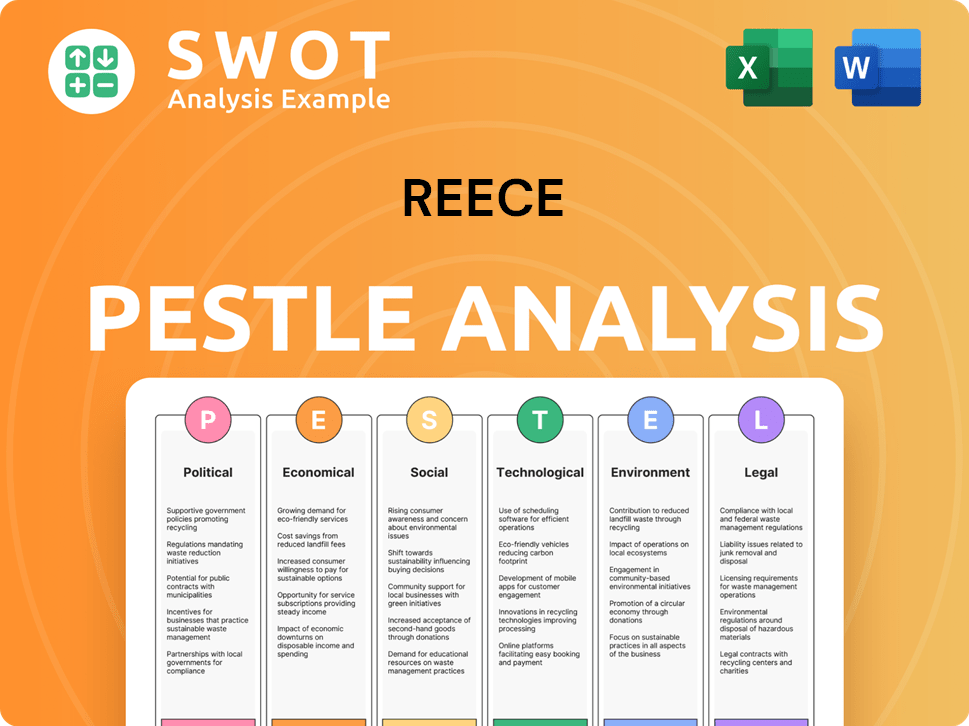
What are the key Milestones in Reece history?
The Reece Company history is marked by significant milestones, reflecting its growth and adaptation in the plumbing and building supplies industry. From its early days to its current status as a major player, the company has consistently expanded its operations and product offerings, solidifying its position in the market.
| Year | Milestone |
|---|---|
| Early Days | The company's origins trace back to its founding, marking the beginning of its journey in the plumbing supplies sector. |
| Expansion | Reece expanded its branch network, increasing its market presence across Australia and internationally. |
| Product Launches | The company introduced new products, such as Flowtite and Thermann Smart Electric, to meet evolving customer needs. |
| Digital Innovation | Reece launched Imagin3D™, a 3D Bathroom Planner tool, to enhance customer experience and address a key pain point. |
| Market Presence | Reece strengthened its market presence through strategic initiatives, including store refurbishments and core capability enhancements. |
Throughout its history, the Reece Group has been at the forefront of innovation, constantly seeking ways to improve customer experience and streamline operations. A notable example is the Imagin3D™ tool, which allows customers to visualize their bathroom renovations. In FY24, the company continued to innovate by launching new products in Australia and New Zealand, including Flowtite and Thermann Smart Electric, demonstrating its commitment to providing cutting-edge solutions.
Launched in 2022, this tool allows customers to visualize bathroom renovations. It addresses a key pain point, with over 30,000 customers using it in the first three months of its pilot program.
In FY24, Reece Australia and New Zealand introduced new products, including Flowtite and Thermann Smart Electric. This expansion reflects the company's commitment to offering innovative solutions and adapting to market demands.
Despite its successes, Reece plumbing has faced challenges, particularly in recent times. The company reported a challenging first half of FY25, with group sales declining by 5% to $2.2 billion and a 3% drop in overall revenue to $4.4 billion, leading to a 19% decline in net profit. The softer housing construction market in Australia and the US has significantly impacted performance, with the US business experiencing a 6.5% decline in sales in US dollars during FY25's first quarter.
The company faced a challenging first half of FY25, with group sales declining by 5% to $2.2 billion. This downturn is largely attributed to a softer housing construction market in both Australia and the US.
The US business experienced a 6.5% decline in sales in US dollars during FY25's first quarter. This was impacted by category deflation and adverse weather conditions.
The company saw a 19% decline in net profit. Management expects near-term challenges to persist in 2025.
Reece Business Model Canvas
- Complete 9-Block Business Model Canvas
- Effortlessly Communicate Your Business Strategy
- Investor-Ready BMC Format
- 100% Editable and Customizable
- Clear and Structured Layout
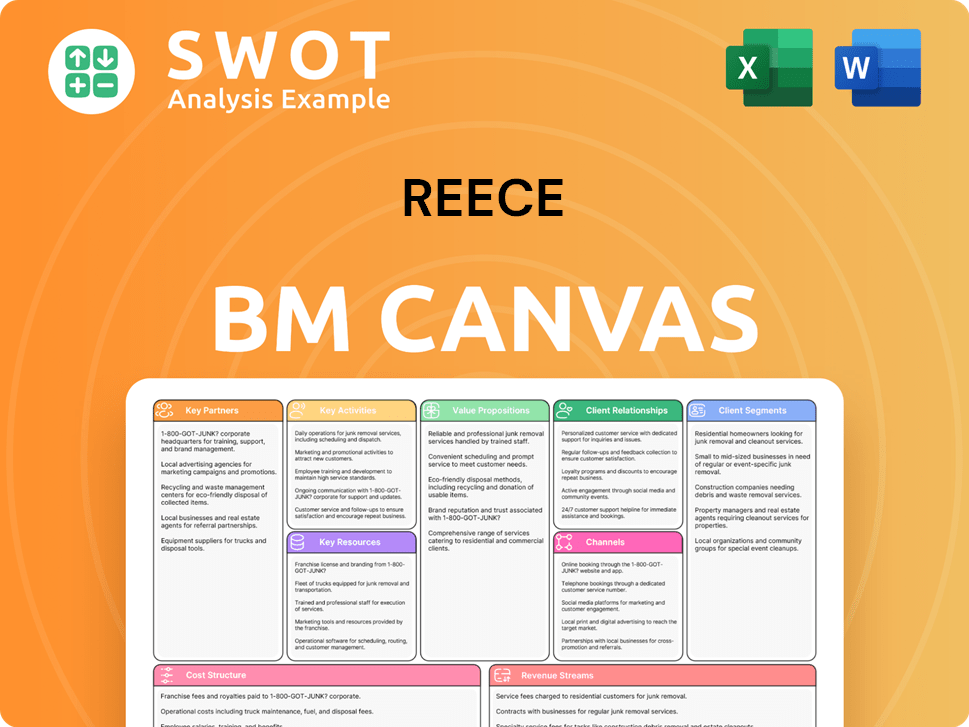
What is the Timeline of Key Events for Reece?
The brief history of Reece Company is a story of consistent growth and strategic expansion, starting from a single truck to a global presence. From its early days in Australia to its significant footprint in the US, the company has continually adapted and expanded its operations, focusing on providing plumbing and bathroom products.
| Year | Key Event |
|---|---|
| 1920 | Harold Joseph Reece begins selling hardware from a truck and opens the first store in Caulfield, Victoria, Australia, marking the inception of the company. |
| 1954 | The company becomes a listed company, a significant step in its corporate journey. |
| 1969 | The Wilson family gains majority control of the company, influencing its future direction. |
| 1970 | Alan Wilson becomes CEO, consolidating the company's operations and setting the stage for future growth. |
| 1974 | The company lists on the Australian Securities Exchange (ASX) on January 1, enhancing its visibility and access to capital. |
| 1997 | The company establishes a nationwide footprint across Australia, expanding its market reach. |
| 2006 | The company expands its operations into New Zealand, extending its presence in the region. |
| 2018 | The company acquires MORSCO for A$1.9 billion, entering the US market and marking a major international expansion. |
| 2022 | The company launches the Imagin3D™ 3D Bathroom Planner tool, integrating technology to enhance customer experience. |
| FY24 (ending June 2024) | Group sales revenue increases 3% to AU$9.1 billion, with adjusted net profit after tax up 3% to AU$416 million, reflecting continued financial strength. |
| FY24 | The company operates 661 branches in ANZ and 243 in the US, demonstrating its extensive network. |
| FY25 Q1 (ending September 2024) | Group sales decline 5% to $2.2 billion due to challenging market conditions, reflecting current economic impacts. |
| HY25 (ending December 2024) | Sales revenue declines 3% to $4.4 billion, and net profit after tax falls 19% to $181 million, attributed to increased costs from business investments and challenging trading conditions. |
The company is forecast to grow earnings and revenue by 9.6% and 4.8% per annum, respectively, with EPS expected to grow by 10% per annum. This indicates strong potential for future financial performance.
The company continues to invest in organic growth, planning to add 10-15 new stores in the US annually. In FY24, they completed 15 refurbishments and added six new branches in ANZ, along with 15 new branches and four refurbishments in the US.
The company continues to build its presence in the less cyclical repair and renovation market in both ANZ and the US, which currently represents only 20% of US revenue. This diversification helps to mitigate market fluctuations.
Despite a challenging near-term outlook for housing markets, the company management emphasizes a long-term view, committing to investments through economic cycles to build a stronger business. The company's 2030 vision aims to be the trade's most valuable partner.
Analysts anticipate a slight recovery in FY26, with revenue projected at $9.3 billion and profit at $400.5 million, followed by $9.8 billion revenue and $452.2 million profit in FY27. This suggests a positive outlook for the future.
The company is well-positioned to resume consistent long-term earnings growth when housing and commercial markets recover, leveraging its extensive branch network and capturing significant organic growth in the vast US plumbing and bathroom products market. The company's history and Reece products demonstrate a strong foundation for continued success.
Reece Porter's Five Forces Analysis
- Covers All 5 Competitive Forces in Detail
- Structured for Consultants, Students, and Founders
- 100% Editable in Microsoft Word & Excel
- Instant Digital Download – Use Immediately
- Compatible with Mac & PC – Fully Unlocked
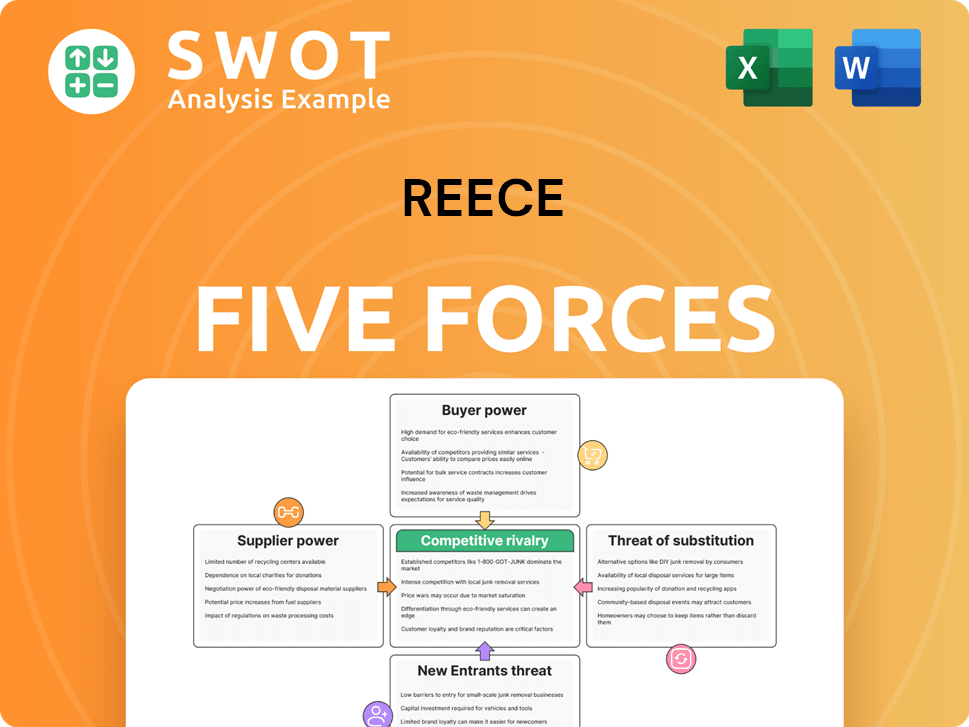
Related Blogs
- What is Competitive Landscape of Reece Company?
- What is Growth Strategy and Future Prospects of Reece Company?
- How Does Reece Company Work?
- What is Sales and Marketing Strategy of Reece Company?
- What is Brief History of Reece Company?
- Who Owns Reece Company?
- What is Customer Demographics and Target Market of Reece Company?
Disclaimer
All information, articles, and product details provided on this website are for general informational and educational purposes only. We do not claim any ownership over, nor do we intend to infringe upon, any trademarks, copyrights, logos, brand names, or other intellectual property mentioned or depicted on this site. Such intellectual property remains the property of its respective owners, and any references here are made solely for identification or informational purposes, without implying any affiliation, endorsement, or partnership.
We make no representations or warranties, express or implied, regarding the accuracy, completeness, or suitability of any content or products presented. Nothing on this website should be construed as legal, tax, investment, financial, medical, or other professional advice. In addition, no part of this site—including articles or product references—constitutes a solicitation, recommendation, endorsement, advertisement, or offer to buy or sell any securities, franchises, or other financial instruments, particularly in jurisdictions where such activity would be unlawful.
All content is of a general nature and may not address the specific circumstances of any individual or entity. It is not a substitute for professional advice or services. Any actions you take based on the information provided here are strictly at your own risk. You accept full responsibility for any decisions or outcomes arising from your use of this website and agree to release us from any liability in connection with your use of, or reliance upon, the content or products found herein.